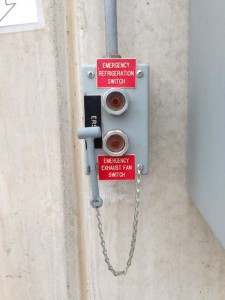Remote Emergency Stop Switches (E-Stops)
Remote Emergency Stop Switches are an integral part of a compliant ammonia refrigeration machinery room. ANSI/IIAR 2-2014 §6.12.1 requires that:
“A clearly identified emergency shut-off switch with a tamper-resistant cover shall be located outside and adjacent to the designated principal machinery room door. The switch shall provide off-only control of refrigerant compressors, refrigerant pumps, and normally closed automatic refrigerant valves located in the machinery room. The function of the switch shall be clearly marked by signage near the controls.”

An E-Stop, as it is commonly referred, is also required in 2013 CMC §1109.4, 2015 UMC §1108.3, 2015 IMC §1106.5.1, 2013 CFC §606.9.1, 2015 NFPA 1 §53.2.3.4.5, 2015 IFC §606.9.1, ANSI/ASHRAE 15-2013 §8.12(i), CSA B52-13 §6.3(h). It is uncommon for such a vast selection of codes and standards to be in agreement, but in this instance the stars have aligned.
Certainly it makes sense that the E-Stop be tested periodically to ensure that this critical safety device is properly working. Title 29 CFR §1910.119(j)(1)(iv) specifically includes Emergency Shutdown Systems in the list of process equipment that must be included in the Mechanical Integrity program. The difficulty in stating a frequency of testing the E-Stop is that current codes do not explicitly state how often such a test must be performed, but consider the following:
There is not a super clear RAGAGEP to point to. The following is my best answer, but its a little convoluted as you will see:
2015 IFC §606.6.1 Periodic Testing.
The following emergency devices or systems shall be periodically tested in accordance with the manufacturer’s instructions and as required by the fire code official
- Treatment and flaring systems.
- Valves and appurtenances necessary to the operation of emergency refrigeration control boxes.
- Fans and associated equipment intended to operate emergency ventilation systems.
- Detection and alarm systems.
2015 IFC does not even require emergency refrigeration control boxes to be installed (replaced them with Emergency Pressure Control System in 2006), however “valves and appurtenances necessary to the operation of emergency refrigeration control boxes” remains included in the most recent version of IFC (likely due to oversight). However, the E-Stop is the primary appurtenance that would be associated with the emergency refrigeration control box. Based on that information and the critical nature of the E-Stop to facility safety, I recommend annual testing of the E-Stop.
In addition, there is enforcement precedent which supports this position:
Agency: U.S. Department of Labor OSHA
Inspection Number: 999148
Inspection Date: 10/8/14
Issuance Date: 2/5/15
Citation 1 Item 6a
Type of Violation: Serious
Proposed Penalty: $7,000.00
29 CFR 1910.119(j)(2): The employer does not ensure written procedures are established and implemented to maintain the on-going mechanical integrity of process equipment.
The violation occurred in the GCS and Main Ammonia Refrigeration Engine Rooms on or about October 8, 2014 and at times prior thereto. Employees were exposed to fire, explosion, and/or · inhalation hazards from ammonia vapors when the employer failed to ensure detailed written procedures were established and implemented for the testing and/or inspection of safety systems. Identified safety systems include but not limited to:
- Compressor Discharge High/Low Pressure
- Compressor High/Low Oil Pressure Differential
- Compressor High Discharge Temperature
- Emergency Shutdown Systems (E-Stop)
- Emergency Ventilation Systems
- High/Low Vessel Levels
- Ammonia Detectors
- Pressure Relief Valve Vents.
Agency: U.S. Department of Labor OSHA
Inspection Number: 999148
Inspection Date: 10/8/14
Issuance Date: 2/5/15
Citation 1 Item 6b
Type of Violation: Serious
Proposed Penalty: $7,000.00
29 CFR 1910.119(j)(4)(i): The employer does not ensure that inspections and tests were performed on process equipment to maintain its mechanical integrity.
The violation occurred in the GCS and Main ammonia refrigeration engine rooms on or about October 8, 2014 and at times prior thereto. Employees were exposed to fire, explosion, and/or inhalation hazards from ammonia vapors when the employer failed to ensure inspection and tests were performed on process equipment such as but not limited to:
- Machine/Engine Room Emergency Shutdown (E-Stop)
- Machine/Engine Room Emergency Ventilation Systems
- Compressor High Discharge Temperature Cut Out
- Ammonia System Shut off /King Valves

Leave a Reply